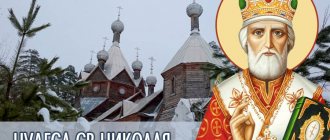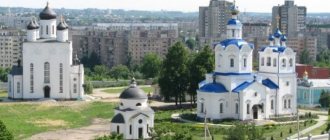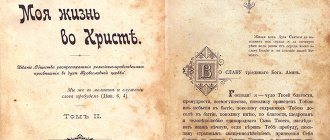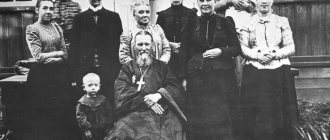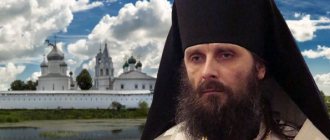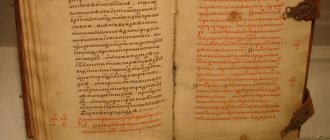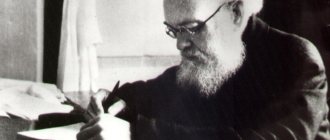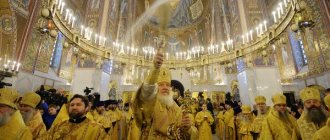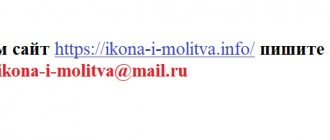Hegumen Damascene (Orlovsky): 1937 – the year of witness to Christ
75 years since the tragic start of the “Great Terror”...
Interview with the historian and hagiographer, Secretary of the Synodal Commission for the Canonization of Saints, author of the multi-volume publication “Martyrs, Confessors and Ascetics of Piety of the Russian Orthodox Church of the 20th Century,” Abbot Damaskin (Orlovsky).
– Father Damascene, during the years of repression there were many terrible and different terrible years. But 1937 is a special year. By the number and brutal nature of repression? Or by some other trait of yours?
– Yes, 1937 was a special year. First of all, of course, in terms of the number and scope of repressions. If from 1921 to 1940 there were 3,080,574 people convicted of so-called “counter-revolutionary crimes”, then in 1937 alone, 790,665 people were arrested under the famous 58th article. And, of course, the year was special in terms of the cruelty of repression. The huge number of people arrested at one time and the shortened period of investigation were accompanied in many cases by painful conditions in prison, which turned into a special kind of torture, beatings during the investigation and various kinds of threats. Of course, we cannot claim that torture was applied to all these hundreds of thousands of people. In many cases, investigators limited themselves to the testimony of witnesses who incriminated a person, and the investigator could always write that the accused so-and-so did not plead guilty, but was incriminated by the testimony of witnesses. For simplified “legal proceedings” with the help of troikas in the NKVD departments, which consider cases in list order, such a procedure was quite sufficient. These are the objective external characteristics of 1937 - the beating by the authorities of their own people - a large number of those arrested, an investigation carried out beyond the boundaries of all legal norms, and simplified legal proceedings. But for a person, it was truly scary because almost none of those arrested people imagined that such a thing could even happen. During the years of Soviet power, having already been arrested once or twice, a person got used to the idea that this was the style of governing the country under the new government - arrest, sentence, release after a certain period, a little life in freedom, arrest again, sentence and so on endlessly. People could not imagine that the anniversary revolutionary year would come, which would be characterized by mass beatings, where all those arrested would be classified into two categories: 1st, those who should have been shot and 2nd, who should have been sentenced to 10 years in prison, and if they survive, then after 10 years they will be exiled again, which of course the victims had no idea about at the time.
Taganskaya prison
What did this mean for a person and, in particular, for a Christian, for whom the idea of death is inextricably linked with the idea of repentance? A person who was arrested in 1937 had to prepare not for life and not for how he would live in prison after the verdict, but for death. The worst thing was being doomed to a violent death without knowing it. Hence sometimes cowardice and some kind of deals with the investigation: people expected to live, but they were almost sentenced to death. What was a person’s experience when he found out about this half an hour before his death - and nothing could be done?! A lesson for a Christian: on earth one must prepare not for life, but for death. Most of those arrested that year were doomed to be shot at the very moment of their arrest; they only had time to prepare for death - sometimes it was only one week from the day of arrest, sometimes a month or two. But they didn't know about it. The scary thing is that a person’s time for repentance was taken away. With all this, one cannot help but say that this year, which almost ceased the physical existence of the Church in Russia, increased the number of its saints.
Reception of prisoners in the prison yard 1930s.
– In the preface to the third volume of your seven-volume work, you write that the repressions of 1937 are related to the results of the USSR population census that took place at the beginning of 1937. Please tell us, the readers, about the results of this census and how they relate to the repression.
– Back in 1935, Stalin and the secretaries of the Central Committee of the All-Union Communist Party (Bolsheviks) A.A. Andreev and N.I. Yezhov, who was to organize the repressions in 1937, became aware that the anti-religious policy pursued in the country was not very successful. For example, in the Ivanovo region there were 2,500 clergy for 2,000 prayer buildings; in the Gorky Territory there were up to 1,500 prayer buildings and more than 1,500 clergy. And throughout the “whole country,” according to the authorities’ calculations, “there were at least 25,000 houses of worship (in 1914 there were up to 50,000 churches).” At the beginning of 1937, on Stalin’s initiative, an all-Union population census took place, in which Stalin also included the question of belonging to social groups and, in particular, to the so-called “clergy,” as well as the question of religion.
1937 census poster.
Of the 98.4 million people over 16 years of age who answered this question, 55.3 million called themselves believers, 42.2 million - non-believers, and 0.9 million did not answer this question. Of the believers, the vast majority - 41.6 million - called themselves Orthodox. The census indicated the failure of the plan to destroy religion through anti-religious propaganda and “soft violence” - camps and exile. The implementation of this plan began to be carried out with the help of terror in 1937.
– In our conversation, we cannot help but touch on the personality of I.V. Stalin. Please tell me, Father Damascene, what evidence is there of his personal initiative in the destruction of the Church in our country during the 1930s?
– Even under Lenin, in 1922, when the Moscow Revolutionary Tribunal sentenced priests innocent of anything before the Soviet regime to death and their fate was decided by the Politburo, it was Stalin who sent a note to all members of the Politburo and wrote: “I personally vote against the abolition of the court decision ", i.e. for execution. And in all cases when the fate of the clergy was decided by the Politburo, Stalin always advocated execution exclusively.
The leader signed not only sentences...
On May 20, 1937, Stalin ordered, through Malenkov, to discuss a proposal - to abolish the church twenties and the governing bodies of church parishes, which could only be done if the parishes ceased to exist. In response to this proposal, on May 26, the head of the NKVD N.I. Yezhov proposed completely abolishing the then existing legislation on cults and creating a commission under the Central Committee of the All-Union Communist Party of Bolsheviks, which would write new legislation. And Stalin, the practitioner, who did not like unnecessary writing, on July 3, 1937, sent Yezhov and all the secretaries of the regional and regional committees and the Central Committee of the National Communist Parties a simple and brief order: to submit within five days “to the Central Committee the composition of the troikas, as well as the number of those subject to execution, as well as the number subject to expulsion." On July 30, the NKVD operational order No. 00447 was adopted, which set “the task of defeating this entire gang of anti-Soviet elements in the most merciless way.” Their number included, according to the authorities’ terminology of that time, “church members.” Thus began the terror of 1937, signed by Stalin. By the end of the terror, out of 25,000 churches, 1,277 remained, and it is unknown whether worship was performed in them. The losses of 1937 for the Church and for the people as a whole turned out to be irreparable, and it is unknown whether the damage that Stalin inflicted on the Church will ever be overcome.
– So, the change in policy towards the Church that took place in 1943 was only a tactical step?
As for the change in policy towards the Church after 1943, this change pursued the only goal - the use of the Church by the state in its foreign policy activities. In this regard, rabid anti-religious propaganda stopped. But churches, just as before, continued to be closed with the knowledge and under the control of Stalin. In particular, “in accordance with the Decree of the Council of People's Commissars of the USSR of December 1, 1944 No. 1643-48/s <...> the public buildings occupied by them during the occupation as houses of worship were confiscated from religious communities, based on the return of these buildings to the Soviet authorities.” The buildings in question were the buildings of churches that were transferred to collective farms after their closure in the 1930s, and during the occupation, they were put in order by believers, so that it became possible to perform divine services in them. By October 1, 1949, 1,150 of the 1,701 buildings had been confiscated. Stalin closely observed this process, as evidenced by his notes on the documents. The head of the MGB regularly reported to him about the arrests of clergy and laity. It is known, for example, that from January 1, 1947 to June 1, 1948, 679 Orthodox churchmen were arrested in the Soviet Union. As of October 1, 1949, there were 3,523 priests imprisoned in the camps. Such was the policy of the state led by Stalin in relation to the Russian Orthodox Church in those years.
– How do you feel about the veneration of Stalin in the church environment?
– Russian people have almost always been in opposition to the existing government. He did not like the absolutist monarchy, which carried elements of the German bureaucracy in its management style. It gave way to a communist dictatorship. The communist dictatorship, even in its weakened form before its collapse, aroused fair protest. It was replaced by a new form, which is perceived by Russian people to a large extent as foreign. This form is also seen by Russian people today as having exhausted its possibilities. And since there are no longer political models in the world that could be borrowed, all the “foreign dresses” are worn and worn out and not a single one fits, then another church person, looking back in search of an ideal, extracts from the past as a “political ideal” Stalin. But this approach is dangerous. Instead of exploring, reflecting and finally looking for the reasons why we had problems in the past, impartially studying our history, we prefer to once again mindlessly bow to a dead political scheme, in this case in the form of the dictatorship of Stalin. It is free to bow to a political idol when he is in the distant past, but it is not so easy to live at his feet during his lifetime. If we ask ourselves whether the church people who lived in the 1930s were happy with Stalin, we can easily answer that none of the church people, being in their right mind and memory, would have said then, covering the ditches of the Butovo training ground with their bodies or awaiting arrest, that he is happy with the dictator. It is also a well-known fact that it was the church society that hesitated during the Second World War, not knowing which dictatorship to choose. By choosing, at least in words, as a political ideal Stalin, a man who brought suffering to millions of people, including church people, we find ourselves in solidarity not with those who suffered, but with those who brought suffering. I can’t name any other reason for this strange Stalinophilia than the reluctance to think about the past, tragic history of our country. But now is not the time to search for a political scheme or a human ideal; we already have an ideal - this is the Lord. And now the time has come for work and reflection, perhaps the hardest work for modern man, because for too long we have been weaned from thinking.
telegram asking to increase the limit
– Father Damascene, before your eyes there were thousands of investigative cases, you witnessed thousands of tragic human destinies. Please tell us about those cases when your confession of faith in Christ was most vivid in your memory.
– This, of course, is Archbishop Andronik (Nikolsky) of Perm and Kungur, who created church work despite merciless persecution; standing in front of the grave and knowing that he would be buried alive, he maintained peace, a deep prayerful attitude and goodwill towards his killers.
Andronik, Bishop of Tikhvin, vicar of the Novgorod diocese
The persecutors themselves subsequently testified to his feat with fear and surprise. And dear to the heart of Archbishop Andronik, Barsanuphius (Lebedev), Bishop of Kirillov, who courageously walked his wonderful path to Calvary. Only the ancient martyrs could have said before their death: “I am not afraid of violent death, but I do not dare to think that the Lord will find me worthy of martyrdom.” And looking at the place of torment, note that a clergyman must go to death without fear, with joy, as at a wedding feast. And Khionia of Arkhangelsk, who had many children, who had eighteen children with her husband (the holy martyr Tikhon, who was shot in October 1937), did not shy away from suffering when the time came, but boldly followed her priest husband to prison, and managed to maintain peace and faith in prison , who accepted the conclusion with humility and, in response to the investigator’s threat, said: “Your will. But I lived, sinned, and must be punished for my sins.”
– What could you tell us about cases of renunciation of Christ? How often did they occur? Do you know of cases of subsequent repentance after renunciation?
– Christians in the twentieth century in Soviet Russia lived in slightly different conditions than the ancient martyrs in the Roman Empire. The Soviet Union had a constitution that stated the freedom to profess any religion. And investigators could torture a person, asking about faith only in secret, without recording this in the interrogation records. In those years, the godless government wanted a little more from a person than verbal renunciation; it wanted a person to collaborate with it in practice, to confirm his unbelief with deeds. Do we consider Alexander Vvedensky, the former archpriest who betrayed Metropolitan of Petrograd Veniamin (Kazansky) to the authorities to death, and his comrades-in-arms in the war against the Church as having renounced Christ or not? Or Mikhail Galkin, a former archpriest who fought with the Church under the pseudonym Gorev. However, there were also enough one-time renouncers. In those mournful years for the Church, their lists were published abundantly in newspapers. We open and read: Akilychev, priest, who served in the church for 23 years, Barminsky, priest, Bestuzhev, deacon, Bogoslovsky, priest, Vinogradov, priest, Vostokov, deacon, Delfontsev, deacon, Znamensky, priest, Kireev, priest, Koryakin, deacon, Krylov, deacon, Lebedev, archpriest, Malygin, priest, Nevsky, priest, Speransky, priest, Trinity, priest, Shepetov, priest, etc., etc., indicating full names, patronymics and place of service. Of course, there were those returning to church service, but this return took place under the watchful supervision of the relevant authorities, so it cannot be completely called repentance, as it was in ancient times. But there were cases when a clergyman, out of cowardice, agreed to betray his brothers, then repented. In other cases, written evidence of his repentance remained. Protodeacon Nikolai Tokhtuev, having made such a choice, wrote to the head of the local NKVD: “Citizen chief!.. What you demand of me, I cannot do... Although I am a family man, in order to be pure before God, I am leaving my family for His sake... my spirit is strengthened and encouraged by the One for whose sake I will go to suffer, and I am sure that He will not leave me until my last breath if I am faithful to Him, and we must all give an account of how we lived on earth... And I can’t serve you as you want, and I’m lying before God. So I want to be cleansed by the sufferings that will be imposed on me by you, and I will accept them with love.” Protodeacon Nikolai was sent to a concentration camp and died in custody.
Protodeacon Nikolai Tokhtuev
– Father Damascene, among the martyrs of 1937 such personalities as Metropolitan Peter (Polyansky), Metropolitan Kirill (Smirnov), and Metropolitan Seraphim (Chichagov) shine. But perhaps, in your opinion, there is someone else who undoubtedly deserves attention, but is undeservedly forgotten, although glorified by the Church?
– Those about whom we can say that these are people of holy life, who have shown constancy and firmness in the confessional feat and courage in martyrdom, but whose lives are not paid enough attention, are quite numerous. In addition to those whom I have already named, the following can also be named. Hieromartyr Thaddeus (Uspensky), Archbishop of Tver, an ascetic from his youth and a man of holy life, impeccable in all respects and a Christian in all circumstances, the most humble bishop of the Russian Church of those years. Hieromartyr Peter (Zverev), Archbishop of Voronezh, ascetic archpastor. Hieromartyr Presbyter John Vostorgov, who during his lifetime did as much for the Church as hundreds of people and dozens of church institutions could have done. Martyr Tatiana Grimblit, who did good to many archpastors and shepherds of the Russian Church. And blessed Nina Kuznetsova, ascetic and martyr.
Martyr Tatiana (Grimblit), icon
Hieromonk Theodore of the Epiphany, the venerable martyr depicted in P. Korin’s painting “Departing Rus'”, the investigation materials of which indicate that no investigation can do anything to a person against his will, and investigators cannot draw up interrogation reports not in accordance with what the person agreed - he may simply not sign them. Blessed Matrona Belyakova, Anemnyasevo ascetic and confessor, whose Christian feat can only be compared with the feat of the ancient ascetics. She was blind - and in the interrogation report the investigator could have written whatever he wanted, and the witnesses obedient to the investigator could have signed it, but this did not happen; clumsily in style, but essentially correctly, they reflected in the interrogation report what she said. This is Archpriest Nikolai Lebedev, who, long before the revolution, took up the feat of combating the vice of drunkenness and set up a shelter for homeless children - under Soviet rule he became a confessor and died in exile. This is Archpriest John Steblin-Kamensky, a holy martyr, who experienced his imprisonment in the Solovetsky concentration camp as a blessed spring for the soul. And many, many others. All of them deserve the attention of church people, and in worship - solemn services and printing their names in bold on the church calendar, at least as a reminder of this. And, first of all, because their feat and their prayers are important for the entire Russian Church.
Priest John Steblin-Kamensky. Leningrad. OGPU prison 1924
There are cases when this or that hieromartyr is not glorified, but undoubtedly evokes the deepest respect - for example, Bishop Theodore (Pozdeevsky) or Bishop Arseny (Zhadanovsky). (And they are also martyrs of 1937). Please explain why we should not be embarrassed that such individuals are not celebrated.
This probably confuses us because we consider the opinion of the Synodal Commission and the decision of the Holy Synod to include the name of this or that person in the calendar as a kind of court, and failure to include it as a sentence. But this is completely untrue. The commission considers only the obstacles to canonization existing in the documents in accordance with the criteria accepted by the Church. However, there are many saints, ascetics of piety, church scientists who have done a lot of work for the good of the Church, and their names are not in the calendar, but we use their works. And this does not bother us. It shouldn't be confusing in this case either.
P. Korin, “Departing Rus'”
– What do you think is necessary for the veneration of the new martyrs to become an urgent need for our Orthodox compatriots?
“We need to read about them, study their lives, compare our own lives with them, compare what is important and significant for us, and what was important and significant for the martyrs.” Do we live by the same values, are we determined to achieve similar goals? It’s important to compare them and us, and primarily because often the persecutors left them nothing but faith in Christ. They were deprived of everything, but can enrich us with much. If we talk about the practical way of updating the veneration of the new martyrs, then we probably need, in addition to the individual lives of the new martyrs currently published, chapters dedicated to them in textbooks and anthologies.
Tatyana's Day
Share with friends:
Find more like this: ANALYTICS
- Share this post:
- StumbleUpon
- Delicious
- Technorati
- Digg
Born on December 26, 1949 in Moscow, abbot. In 1979 he graduated from the A.M. Gorky Literary Institute at the Union of Writers of the USSR. He worked in the educational and methodological office at the USSR Ministry of Instrument Engineering. From 1983 to 1986 he served as a reader in the Assumption Church in the village of Zilina, Moscow region.
On April 7, 1988, in the Transfiguration Cathedral in Ivanovo, he was tonsured into a mantle with the name Damascene in honor of St. John of Damascus. On December 28, 1988, Bishop Ambrose (Shchurov) of Ivanovo and Kineshma ordained him a deacon, and on December 29 of the same year, he was ordained a priest. Sent to serve in the Resurrection Church in the village. Tolpygino, Privolzhsky district, Ivanovo region.
In 1991, he was included in the Synodal Commission for the study of materials concerning the rehabilitation of the clergy and laity of the Russian Orthodox Church who suffered during the Soviet period; in 1996 - member of the Synodal Commission for the Canonization of Saints.
On April 9, 1996, by decree of His Holiness Patriarch of Moscow and All Rus', Alexy II was appointed to the clergy of the Church of the Intercession of the Most Holy Theotokos on Lyshchikova Mountain.
On January 9, 2000, he was elevated to the rank of abbot.
Since the late 70s, Abbot Damascene has been systematically collecting materials concerning the feat of the new martyrs and confessors of Russia in the 20th century. Before 1990, research was conducted primarily by obtaining testimonies and identifying all available published sources.
Since 1991, Abbot Damaskin began studying archival and investigative cases in the Central Administration of the KGB of the USSR (now the Central Administration of the FSB of the Russian Federation). Subsequently, materials from the Archives of the President of the Russian Federation, GARF, RGIA, archives of the FSB Directorate for Moscow and the Moscow Region and the Prosecutor's Office of the Tver Region were also studied. The materials collected by Abbot Damascene about the life and exploits of the new martyrs were presented to the Synodal Commission for the Canonization of Saints and served as the basis for their glorification at the Council of New Martyrs and Confessors of Russia.
Hegumen Damascene is the author of a scientific methodology for the comprehensive study of materials related to the martyrdom and confessional feat of saints of the 20th century. He continued the hagiography tradition, interrupted in the 20th century, restoring it on the principles of early Christian hagiography, when hagiographies were created on the basis of official documented and oral evidence.
Fundamental for the development of Russian hagiography at the turn of the 20th and 21st centuries was the work of Hegumen Damascene “Martyrs, confessors and ascetics of piety of the Russian Orthodox Church of the 20th century. Biographies and materials for them" (Tver, 1992-2002. 7 books).
The publication includes more than 900 lives and biographies, calendars of memory of new martyrs and confessors. The author used materials from the archives of the FSB, the President of the Russian Federation, former party members, etc., incl. regional. The bulk of the sources consisted of judicial investigation cases. The hagiographer also used thousands of testimonies of eyewitnesses and participants in the events, collected by him in the 70s and 80s of the 20th century.
For this work, in 1997 he was awarded the Metropolitan Macarius Prize (for the 1st and 2nd books) and in 2002 - the Union of Writers of Russia (for the 6th book). The lives compiled by Abbot Damascus were also published in the collections “Lives of the New Martyrs and Confessors of the Russian 20th Century of the Moscow Diocese” (Tver, 2002-2005. Vol. 1-5, add. 1-4).
In 2005, the publication of the complete collection of “Lives of the New Martyrs and Confessors of the Russian 20th Century” compiled by Abbot Damascene began in accordance with their church memory by month. (Tver, 2005-2008. January, February, March, April, May, June, cont.).
Since 1997, Abbot Damaskin has been the scientific director of the regional public foundation “Memory of Martyrs and Confessors of the Russian Orthodox Church,” whose goals are to study archival documents and other evidence relating to the feat of Russian martyrs and confessors, and to publish the spiritual heritage of the martyrs.
In 2002-2009, books of works by the holy martyrs of Tver Archbishop Thaddeus (Uspensky), Perm Archbishop Andronik (Nikolsky), Kursk Archbishop Onufry (Gagalyuk), Voronezh Archbishop Peter (Zverev), Bishop of Kamenets-Podolsk and Bratslav Ambrose (Polyansky), Bishop Peter and Paul Methodius (Krasnoperov), Metropolitan of Kyiv and Galicia Vladimir (Epiphany).
Hegumen Damascene is the author of numerous articles and participant in scientific conferences on the history of the Russian Orthodox Church in the 20th century, as well as a series of television programs about the new martyrs and confessors of Russia. The books of Hegumen Damascene have been translated into English, German, Serbian and Romanian.
Hegumen Damascene is the secretary of the Synodal Commission of the Russian Orthodox Church for the canonization of saints, a member of the council for the publication of the “Monuments of Church Literature” and “Slavic World” series, the editorial board of the scientific series “Materials on the Contemporary History of the Russian Orthodox Church,” and the scientific and editorial council of the Orthodox Encyclopedia. Member of the Russian Writers' Union.
Orthodox Life
– Father Damascus, the life of the Church from the first centuries was built on the exploits of martyrs. How does the feat of the new martyrs differ from the feat of the martyrs of the first centuries of Christianity? And how does studying their lives differ from studying the lives of ancient martyrs?
– The feat itself, its qualitative content has not changed in any way; the same Christian with faith in the risen Christ stood before God in ancient times, stood before God in the 20th century. It was not the content of the Christian feat that changed, but the circumstances in which this feat began to be performed. If Christians of the first centuries were persecuted only for the fact that they were Christians, Christianity itself outlawed them, then during the persecution in the twentieth century, Christianity was not declared criminal and worthy of death, as it was in ancient times.
From a Christian in the twentieth century. They did not always demand renunciation of Christ. The main thing has become not who you say you are, but who you really are. You can call yourself a Christian, but not actually be one. Therefore, if the life of the ancient martyrs was considered according to one criterion - their faith in Christ, then the life of those who suffered from the authorities in the 20th century is considered according to many characteristics. And the approach to studying them is personal, that is, we need to study a person’s life in order to understand who is in front of us. The authorities at that time were quite happy with the situation for Christians to be Christians only in name or to secretly help the persecutors. Therefore, in those years, Christians by name could be apostates from the faith, false witnesses against their neighbors and people of a lifestyle unworthy of a Christian. And at the same time, everyone must suffer like many of our glorious martyrs, those for whom there was nothing more precious and beautiful than the Church of Christ. This means that the methodology for studying the lives of martyrs, with church criteria remaining unchanged, has become different.
In the 20th century A political phenomenon that had not existed before - a totalitarian state - appeared on the historical stage. How can you characterize it? The totality and power of state pressure on an individual, when all the material and psychological power organized by the state was used, when in order to break and crush this or that person with an ideology that was hostile, as the authorities considered, all the levers and capabilities of the state machine were used. A church person found himself almost as if in a foreign, some kind of “Babylonian” captivity, but unlike ordinary captivity during interstate wars, he then had nowhere to run except Heaven. Under these conditions, some, in order to save their lives, made a deal with their conscience. Can they be called confessors or martyrs, even though they subsequently suffered a violent death? The feat of the new martyrs also differs in terms of the conditions of the investigative process, which in the twentieth century. in contrast to the open process in ancient times, it was closed from others and is almost inaccessible for full study at the present time, because the body of documents of judicial investigative cases, which is now mainly studied, reflects only part of the life of the injured clergyman or layman, and as part of the information the whole may not be sufficient to reconstruct events. The Church is now accused of allegedly completely trusting everything written in the interrogation reports of the accused.
However, it is not. Everyone understands perfectly well that people at that time were falsely accused of crimes that were not committed. And in this case, it is not the accusation itself that is important, but the position of the accused in relation to the accusation brought against him. At the Councils of Bishops, it was stated with the utmost clarity more than once that there are “no grounds for the canonization of persons who, during the investigation, incriminated themselves or others, causing the arrest, suffering or death of innocent people, despite the fact that they suffered. The cowardice they showed in such circumstances cannot serve as an example, for canonization is evidence of the holiness and courage of the ascetic, which the Church of Christ calls its children to imitate” (see: Report of Metropolitan Juvenaly of Krutitsky and Kolomna, Chairman of the Synodal Commission for the Canonization of Saints, on Bishops' Jubilee Council. M.: Cathedral of Christ the Savior, August 13–16, 2000).
There were cases when people who found themselves face to face with persecutors bore false witness, betrayed their souls, and under pressure from investigators signed texts that they would never have signed under other circumstances. They say that the investigators had methods of influence, torture, etc. But this objection is beyond criticism, because in this case we are not talking about people in general, but about holy martyrs, not in general about unjust victims, but about those whose behavior in the face death was flawless in every way. A reference to the conditions of the investigation of the twentieth century, making perjury excusable, would mean a change in the canonization criteria accepted by the Church, which always considered the merits of the martyr’s feat and did not seek justification for sin in the severity of torture, under which moral and religious principles could be abandoned.
Worship cross in Butovo
We can only call those who are glorified by the Russian Orthodox Church new martyrs. In accordance with the decision of the Holy Synod of February 16, 1999, we call only those glorified by the Church holy martyrs; the names of the rest, Thou, Lord, weigh. This formula and the non-inclusion of those not glorified by name in the list of new martyrs allows, in accordance with the definition of the Holy Synod, “to exclude from the rank of veneration those who died outside the Orthodox Church, having fallen away from it due to a church schism, or because of betrayal, or for non-church reasons” ( Canonization of saints in the twentieth century. M., 1999). So it would be a mistake to call those who suffered but were not glorified by the Church as new martyrs.
– What did the new martyrs and confessors of the Russian Church have to renounce in the first place for the sake of fidelity to Christ, what deprivations did they accept in life?
– First of all, in order to avoid persecution during the years of Soviet power, believers had to hide the fact that they were believers. In those years, if a person remained faithful to Christ, he could lose his job and generally be left without a livelihood, he could be arrested, imprisoned or sent into exile. Persecution concerned not only adult family members, but also children, who could be persecuted in schools for wearing a cross or for attending religious services. Accordingly, parents have always lived under the threat of deprivation of parental rights for raising children in a religious spirit. A believer should have been ready at that time to lose everything, but not be ashamed of Christ and His words.
– During the years of persecution of the Orthodox Church in the country, there was, as we would now say, a family crisis: the official policy of the godless government inculcated the cult of worship of material wealth, imposed freedom of relationships for spouses, public education of children according to standard state programs, which were based on the principles of godlessness and depersonalization. Today we are reaping the bitter fruits of the experiments of the Soviet regime. Can the life experience of the new martyrs and confessors of the Russian Church help modern spouses in resisting this external pressure, as well as in raising children?
– For a family to be able to resist modern temptations, the family itself must be Christian. Modern temptations can only be countered by a different content of life - Christian content. One must, first of all, be a Christian, and then the temptations of this world will not touch a person’s soul. The experience of the new martyrs clearly testifies to this. At that time, many Christian families of laity and clergy were not afraid of anything, well understanding that their only strong support in this life was the Christian faith. In this sense, modern man is not so much seduced by the world as he is seduced himself, often looking for temptations himself and not looking for how and with what to spiritually feed his soul in order to save it.
Going through the family field requires a lot of effort from a person; without exaggeration, we can say that this is a feat. The Church symbolizes marriage with martyr's crowns, bestowing grace-filled strength on the spouses so that for the worthy and ascetic bearing of this cross on earth they will be crowned in the Kingdom of Heaven.
Arrival at the elephant
An example of family life was, for example, the Hieromartyr Tikhon and his wife, confessor Chionia, of Arkhangelsk, glorified in the Council of New Martyrs and Confessors of the Russian Church. They lived in the Voronezh region, where Father Tikhon served as a priest. They had 18 children. The couple raised their children without being embarrassed by poverty, teaching their children to do all kinds of work, which helped them subsequently survive many hardships.
The mother, Khionia Ivanovna, was involved in raising the children. She taught the children to pray and to turn to God in all difficulties. On all major and minor church holidays, the children went to church with her. She taught them to fast in accordance with church regulations. During Lent, the reading of secular books was postponed and the Law of God was read. The children retold what they read to their father or mother. Since there was little free time from work then, they retold the story while they were working - in the garden, in the field, or doing handicrafts.
On August 9, 1937, Father Tikhon was arrested. “Are there any weapons?” – the NKVD officer asked him. “There is,” answered the priest, “the cross and prayer!” Archpriest Tikhon Arkhangelsky was executed on October 17, 1937. Before the execution, the executioner asked him: “Will you not renounce?” - “No, I won’t renounce!” - answered the priest.
On December 12, 1937, authorities arrested Khionia Ivanovna. A few days later, the courageous confessor wrote to the children from prison: “My dear children, I’ve been in a cage for three days, but I think it’s an eternity. There was no formal interrogation yet, but they asked if I believed that God saved the Jews by drowning the Pharaoh in the sea, I said: I believe, and for this they called me a Trotskyist, who need to be destroyed as enemies of the Soviet regime... God bless you and Him Most Pure Mother..."
On December 31, 1937, the NKVD troika sentenced Khionia Ivanovna to eight years in prison. Khionia Ivanovna died in December 1945, becoming, together with her husband, Hieromartyr Tikhon, a Christian example of raising children and a prayer book for all those striving for a pious family life.
– To endure interrogations and torture in dungeons was beyond human strength. What helped the new martyrs to remain faithful to the gospel truth to the end and at the same time preserve human dignity?
Lights of Russia of the 20th century
– For the new martyrs, the trials that came became an exam that they passed to God, who was gracious to them. The main difficulty and sorrow of the martyrs of the twentieth century was not in torture, but in the fact that they could not wait out persecution and torment, exile and imprisonment, as happened in ancient times, when all persecution eventually ended and people could again begin to live their usual lives. them with life, almost not pursued. Our new martyrs and confessors had to live under conditions of persecution, imprisonment and exile throughout their lives.
What qualities did they need to endure all this with dignity? First of all, such a very useful virtue for a person as patience. “Through your patience save your souls... He who endures to the end will be saved,” says the Lord. This virtue, growing, helped the martyr to see the Providence of God in his life, the active participation of God in it, which in itself strengthened his spiritual strength. The second thing that helped to endure trials and at the same time was the fruit of patience shown in trials was the deepest Christian humility. It was this main virtue that suffering taught; thanks to this divine virtue, the martyrs were able to endure all the trials.
For the new martyrs and confessors, the persecution that befell them in the twentieth century was not a factor of external violence. For them, these were circumstances in which the Lord placed them not only to suffer, but also to live. And what could be more comforting for the new martyrs and confessors than to know that the Lord is always with them - both in a prison cell and behind the barbed wire of a concentration camp.
“Are you asking when my torment will end? – Hieromartyr Hilarion (Troitsky) wrote from prison. – I will answer this way: I do not recognize torment and do not suffer. With my “experience”… you won’t surprise or frighten me with prison. I’m already used to not sitting, but living in prison...”
– You have taken upon yourself the extraordinary work of studying the feat of the new martyrs and confessors of the Russian Church and compiling complete biographies. What inspired you to do this and what is your current job?
– Of course, first of all, there is a duty to the Church, an awareness of the need for this to be done, and the fact that this can be accomplished within a certain time frame. There are things that can be done either now, or already, at least in the proper volumes, that will be difficult to do ever. Lives are written on the basis of research in various archival funds, and the methodology for researching and writing the lives of new martyrs is similar to how the lives of ancient martyrs were written.
DAMASCINE
(Orlovsky Vladimir Aleksandrovich; born December 26, 1949, Moscow), abbot. In 1979 he graduated from the Literary Institute. A. M. Gorky at the Union of Writers of the USSR. He worked in the educational and methodological office at the USSR Ministry of Instrument Engineering. From 1983 to 1986 he served as a reader at the Assumption Church. With. Zilina, Moscow region. Apr 7 1988, in the Transfiguration Cathedral of Ivanovo, he was tonsured into a mantle with the name Damascene in honor of St. John of Damascus. 28 Dec 1988 Bishop of Ivanovo and Kineshma Ambrose (Shchurov) ordained a deacon, December 29. the same year - to priest. Sent to serve in the Resurrection Church in the village. Tolpygino, Privolzhsky district, Ivanovo region. In 1991, he was included in the Synodal Commission for the study of materials relating to the rehabilitation of the clergy and laity who suffered during the Soviet period; in 1996 - member of the Synodal Commission for the Canonization of Saints. Apr 9 1996, by decree of His Holiness Patriarch of Moscow and All Rus', Alexy II was appointed to the clergy of the Church of the Intercession of the Most Holy. Mother of God on Lyshchikova Mountain. 9 Jan 2000 elevated to the rank of abbot.
Since 1980, D. has been systematically collecting materials concerning the feat of the new martyrs and confessors of the Russian twentieth century. Before 1990, research was conducted primarily by obtaining testimonies and identifying all available published sources. Since 1991, D. began studying archival and investigative cases in the Central Administration of the KGB under the Council of Ministers of the USSR (now the FSB of the Russian Federation). Subsequently, materials from the Archives of the President of the Russian Federation, GARF, RGIA, and archives of the FSB Directorate for Moscow and the Moscow Region were also studied. and the prosecutor's office of the Tver region. As a result, more than 100 thousand complex of judicial investigation cases for the period 1917 - 50s were studied. XX century
The materials collected by D. about the life and exploits of the new martyrs were presented to the Synodal Commission for the Canonization of Saints and served as the basis for their glorification at the Council of New Martyrs and Confessors of Russia. As a result of research concerning the study of the places where repressions took place and the burial places of martyrs and devotees of piety, in particular, the relics of the holy martyrs Peter (Zverev), Archbishop. Voronezh, Thaddeus (Uspensky), Archbishop. Tverskoy, prot. Konstantin Golubev, priests Alexander Smirnov and Fyodor Remizov, priests Agafangel (Preobrazhensky), Metropolitan. Yaroslavsky, Victor (Ostrovidov), bishop. Glazovsky, Roman Medved, St. right Alexia (Gneusheva), Rev. Alexandra (Orudova), Venerable Jesus of Anzersky, martyr. Alexy Voroshina, martyrs Evdokia Sheikova, Daria Timagina, Daria Ulybina and Maria, martyr. Nizhny Novgorod.
D. is the author of a scientific methodology for the comprehensive study of materials related to the martyrdom and confessional feat of saints of the 20th century. He continued what was interrupted in the twentieth century. hagiographic tradition, restoring it on the principles of early Christ. hagiography, when lives were created on the basis of official. documented and oral evidence. In 1992-2002 D. was prepared for printing and published 7 collections “Martyrs, Confessors and Ascetics of Piety of the Russian Orthodox Church of the 20th Century”, containing approx. 900 Lives. For this work he was awarded the Metropolitan Prize. Makarii 1997 (for the 1st and 2nd books) and the Union of Writers of Russia 2002 (for the 6th book). The lives compiled by D. were also published in the collections “Lives of the New Martyrs and Confessors of the Russian 20th Century of the Moscow Diocese” (Tver, 2002-2005. Vol. 1-5, add. 1-4). In 2005, the publication of the complete collection “Lives of the New Martyrs and Confessors of the Russian 20th Century” began. in accordance with their church memory by month (Tver, 2005-2006. Jan., Feb., March, Apr., cont.).
Since 1997, D. has been the chairman of the regional public foundation “Memory of the Martyrs and Confessors of the Russian Orthodox Church,” whose goals are the study of archival documents and other evidence relating to the feat of the Russian martyrs and confessors, and the publication of the spiritual heritage of the martyrs. In 2002-2004 books of the works of the holy martyrs of the Tver archbishop were published. Thaddeus (Uspensky) and Perm Archbishop. Andronik (Nikolsky).
D. is the author of numerous articles and participant in scientific conferences on the history of the Russian Orthodox Church in the twentieth century, as well as a series of television programs about the new martyrs and confessors of Russia. D. is a member of the council for the publication of the series “Monuments of Church Literature” and “Slavic World”, the editorial board of the scientific series “Materials on the Contemporary History of the Russian Orthodox Church”, and the scientific and editorial council of PE. Member of the Russian Writers' Union.
In 2000, for his work on the Synodal Commission for the Canonization of Saints, he was awarded the medal of the Russian Orthodox Church St. Innocent of Moscow and Kolomna.
Definition of the Holy
Synod of July 27, 2011, he was appointed secretary of the Synodal Commission for the Canonization of Saints. Works: Biography of Archbishop. Hilarion (Troitsky) // Hilarion (Troitsky), Archbishop. Church as a union of love / PSTBI. M., 1998. P. 5-68; Persecution of the Russian Orthodox Church in the Soviet period // PE. T.: ROC. pp. 179-189; Life of Archimandrite Sergius (Srebryansky) // ZhMP. 1999. No. 3. P. 39-55; Biography of Archimandrite. Ignatius (Biryukova), schisp. // East. Vestn. 1999. No. 2. P. 101-113; History of the Russian Orthodox Church in documents from the Archive of the President of the Russian Federation // Dedicated to the 200th anniversary of the Nativity of Christ / Russian State University for the Humanities. M., 2001. P. 78-112; Lives in the preface to the ed.: Thaddeus (Uspensky), Archbishop. Tverskoy, sschmch. Creations. Tver, 2002. Book. 1: Sermons. pp. 5-28; Ambrose (Polyansky), bishop. Kamenets-Podolsky and Bratslavsky, schisp. The doctrine of the Kingdom of God according to op. blzh. Augustine "On the City of God". Tver, 2003. P. 5-22; Peter (Zverev), archbishop. Voronezh, sschmch. Exegetical analysis of the first two chapters of the Epistle of St. Paul to the Hebrews. Tver, 2004. P. 5-106; Andronik (Nikolsky), archbishop. Perm, sschmch. Creations. Book 1: Articles and notes. Tver, 2004. P. 5-59; Onuphry (Gagalyuk), archbishop. Kursky, sschmch. Creations. Tver, 2005. T. 1. P. 5-76; Tatiana (Grimblit), MC. Poems. Tver, 2006; Ioann Popov, martyr. Patrology. Tver, 2006.
